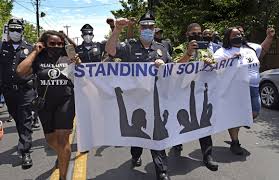
Working from the Edge
This is the second of four blog posts on innovation. Like the series I recently wrote on responses to the COVID-19 crisis, it is being written in the middle of a crisis, the third one Americans have had to face in the span of three months. In the first four months of 2020, we have to respond to the Coronavirus pandemic and the economic shock it led to. This month, we have had to add racial crisis to the mix now that the murder of George Floyd has unleashed a protest movement on paralleled scope and size, all in a span of two weeks.
Last week, I laid out two broad pathways toward innovation that all of us should pursue if we are serious about tackling the current crises as part of the single, interrelated set of “wicked” problems that have been plaguing the United States and most of the rest of the world for decades—not weeks or months.

Schedule
Here is a schedule of this four part series:
June 5 Innovation for Social Change
June 12 Working From the Edge
June 19 Virtuous Circles
June 26 Look Inward to Look Outward—And Vice Versa
This week, I’ll talk about, frankly, the sexier of the two approaches to innovation one finds in what we academics pompously call “the literature.” Unfortunately, producing innovations that truly get us outside the clichéd box are few and far between.
Outside the Box
That’s the case for two overlapping reasons, the second of which I’ll defer until the fourth and final blog post. What the Arbinger Institute call our personal boxes make it hard for us to emotionally get beyond our blinders and prejudices so that we can treat others—and especially the people we disagree with—as truly human.
For the moment, it’s enough to think of being stuck inside the box in the way that we usually use the term. Most of us have a hard time even being able to envision alternatives to the status quo.
I could illustrate that with the iPhone or yet another technological example, which is what most commentators tend to do. However, it makes more sense to use the example of street addresses, because I read Deirdre Mask’s delightful and eye opening The Address Book while I was drafting this post.
I don’t know about you, but I never thought about street names and numbers in anything approaching a systematic matter despite the fact that I write and teach about a lot of places as a result of my work as a comparative politics and peacebuilding scholar.
But reading her book led me to think more generally about things that had at most been at the edge of my conscious mind. What difference would it make if I didn’t have an address? Where do city and street names come from? Why did someone call my street Primrose Drive? What significance do the four digits in my address mean? Why do we have a zip or other postal code? What biases does any of this reflect?
It turns out that those biases exist all over the places when you give out address and give names to places. As Mask points out, those practices tell us a lot about the class, racial, ethnic, and gender biases in a given society.
I’m not trying to get you, too, to think about addressing. Rather, simply note that it is hard to think outside the box if that means thinking about things you’ve rarely thought about before. Yet, that’s what produces game-changing innovations like the iPhone or Netflix or new political movements that lead to new public policies.
The First View from the Edge—What We Have to Learn
One way to get there is to work from the “edge” of your field by taking to heart insights developed by John Hagel and John Seely Brown which do at least make earth shattering innovations possible.
 Their writings and the Center for the Edge they created at Deloitte are by no means the last word on the subject. Still, the metaphor of sitting on the edge of your field and looking outward has helped me see one way I could help introduce game-changing innovations into peacebuilding, including using systems analysis, thinking in terms of wicked problems, and adding the United States to the list of “conflict zones” we work in.
Their writings and the Center for the Edge they created at Deloitte are by no means the last word on the subject. Still, the metaphor of sitting on the edge of your field and looking outward has helped me see one way I could help introduce game-changing innovations into peacebuilding, including using systems analysis, thinking in terms of wicked problems, and adding the United States to the list of “conflict zones” we work in.
Perhaps because I’ve spent the last few years on the edge and fixed my gaze outward, I find it easiest to see what they have in mind by taking an example as far from peacebuilding as I can imagine–why Singapore has been so successful.
There are many reasons why Singapore has done so well.
Near the top of the list is the fact that it is the only country I know of that has had a government unit that does just that—its Risk Assessment and Horizon Scanning unit.
As this video by its former head, Peter Ho, suggests, Singapore is a tiny, fragile country that has to be nimble on its collective and metaphoric feet if it wants to maintain its spectacular rate of growth and prosperity. So, its government spearheads an effort to anticipate global trends which is what horizon scanning and risk assessment are all about. It can then use its (admittedly less than democratic) government to respond.
Let me be clear about the one point I’m trying to make here. Singapore systematically looks for innovative ideas that would not have percolated “up” from its own business community or civil society. Time and time again, it has come up with ways of adapting to rapidly changing global economic conditions so that it could take advantage of its location, diverse population, educational system, and other resources to find and fill profitable niches.
An Example from Today’s News—Defunding and Restructuring Policing
Today, we don’t have to look as far as Singapore or to as small a field as peacebuilding to see why this kind of innovation is important. Since George Floyd’s murder, there has been an example of how it can happen in our news every day.
A month ago, radical reform of policing in the United States was not on the table, at least for mainstream American citizens and policy makers. As a political scientist and peacebuilding, I would make the case that it should have been. However, that’s not the point here.
Floyd’s murder and the protests, repression, and media coverage that followed it changed that situation overnight. Now, everyone is taking the possibility of redefining law enforcement and even defunding entire police departments seriously.
All of a sudden, activists, journalists, and policy makers are creating their own version of RAHS or a Hagel/Brown-style edge lab. And, we are learning about communities that set up something akin to an edge lab without having even heard of the term.
 We are all looking seriously at the lessons learned when a city like Camden NJ or Las Vegas NV rebuilt their police departments from scratch. Less sweeping efforts in cities like Houston have gained new prominence. The role of advisors like Arbinger Institute with the Kansas City police are being reviewed with an interest we never saw before. Others are looking outside the United States to see how less fully armed police departments deal with protest and civil unrest. We are also looking at broader questions of power, ranging from our absurdly high rate of incarceration and recidivism to the patterns of systematic racism and power in our country.
We are all looking seriously at the lessons learned when a city like Camden NJ or Las Vegas NV rebuilt their police departments from scratch. Less sweeping efforts in cities like Houston have gained new prominence. The role of advisors like Arbinger Institute with the Kansas City police are being reviewed with an interest we never saw before. Others are looking outside the United States to see how less fully armed police departments deal with protest and civil unrest. We are also looking at broader questions of power, ranging from our absurdly high rate of incarceration and recidivism to the patterns of systematic racism and power in our country.
As Camden’s story (or, for that matter, any edge inspired innovation) suggests, there’s a lot of hard work and emotional pain involved. Camden had hit rock bottom on a number of fronts a decade ago. What set it apart, however, was the willingness of city authorities and average citizens to look “outside of the box” for ideas that they could then adapt to that troubled community’s needs. The Democratic city leaders and the Republican governor found that they could make common cause and use an existing state law that allowed municipal police forces to be merged into county-wide units. That would save money and make Governor Christie’s office happy. But, it also allowed the city to break the power of the powerful police union and its often racist officers. It would rebuild the police force and its operating cultural norms from scratch.
The results are easy to see. Police officers gladly marched with protesters this month. More importantly, police-community relations are far better. Officer misconduct complaints and crime rates are both way down.
I’m no expert on police reform and you should not read these lines as an endorsement of any particular way forward. Instead, I simply want you to see that the crisis has forced people in Camden and elsewhere to consider sweeping innovations that were either considered implausible or weren’t even on our radar screens a few short weeks ago.
The Second View From the Edge—What We Have to Offer
To my surprise, I’ve found a second valuable way to work using the edge as a starting point.
Perhaps because peacebuilding is a new and small field, I had always thought that working from the edge meant that I only had to look in one direction—outward. Whether it was my own inferiority complex or that of my field as a whole, I assumed that we had a lot to learn from colleagues in environmental science, public health, management, information technology, and more. Most of what I’ve read in the last few years has come from those fields, most recently in the book on street addresses I mentioned a few paragraphs ago.
However, in discussions I’ve been having with people in those fields about the current crises, I’ve realized that we have a lot to offer from our side of the edge. In other words, we have something to add when we look out from the edge of peacebuilding into the movements that focus on the issues that are roiling the world today.
I could go on and on and talk about all of those issues—and I probably will do just that if I decide to write another book. However, for the purposes of a single blog post, let me limit myself to the question of policing. As I do, let me stress again that I’m by no means an expert and use it here as food for thought. After all, that’s why many authors today write posts before they write books and use the informal, tentative nature of the blog to try out new ideas.
As I watch the divisions over the proper policies to deal with the coronavirus and then the protests following George Floyd’s murder, I realized that we have things to offer to those discussions that come from “inside” our own edge.
My colleagues and I are partisans in those disputes. Most of us support strict versions of the shutdown and other public health related steps in response to the pandemic. Most of us support black lives matter, radical police reform, and more.
What we add to those debates is a way having the often intense discussions they lead to. We see the importance, in particular, of not treating the people you disagree with as enemies. The minute I demonize my political opponents, I drive the wedge between us deeper. Finding any sort of agreement becomes all the harder. Instead, we have a pretty good idea of what it takes to become what we at the Mary Hoch Center at George Mason University call “insider reconcilers.”
We know that we will continue to live in the same society as the people we disagree with. We know that many of them will not be happy with the reforms we want to implement—should we be able to get new laws passed and new cultural norms adopted. We are not going to let up in our advocacy for racial justice, a response to climate change, and the like.
Our difference from conventional activists lies in the ways we approach the people we disagree with in two main ways that are in relatively short supply these days on the “other side” of the edge:
- Treat everyone with respect. I do not agree with the policies being pursued by the current administration and I want them to change. I’ll try to compel them to do so if they con’t come on board voluntarily. However, I also know that I am going to be living with them in a more egalitarian America, and I want those relationships to be as harmonious as possible. If there is going to be any chance of that happening, I have to treat them with the same respect I want them to show toward me. Disagreeing with other human beings requires treating them as human beings. That’s no mean feat during charged times like these.
- Take the first step. It’s even more important for me to take the first step and invite others to work with me in finding a solution. Especially the people I disagree with. Too often, we see the other person as the source of the problem and wait for him/her to take the first step. They, of course, think the same way about me. Therefore, little or nothing constructive happens. But, what happens when I reach out and take the first tentative step. Once you do, it becomes easier for police officers in Camden to join protest marches and to begin the kind of lengthy, complicated process of producing tangible changes which I’ll focus on next time.
A Third View From the Edge—Non-incremental Change
These skills are needed now more than ever.
I’ll spend a lot of time in the fourth blog post talking about Chad Ford and his work on what he calls Dangerous Love in which he stresses the importance of taking that first step toward our adversaries. As he puts it, when we do so, possibilities and opportunities open up
Next time, I’ll talk about how the kinds of incremental steps one can take in the short run can built together and build the kind of paradigm shift in so many aspects of our lives that we need today. In the process, I’ll return to the case of Camden and its police force and explore how big ideas can move from the edge into the policy making mainstream.
The views and opinions expressed in this article are those of the author and do not necessarily reflect the official policy or position of the Alliance for Peacebuilding or its members.
Also published on Medium.
